2017 Hyundai Elantra belt
[x] Cancel search: beltPage 38 of 571
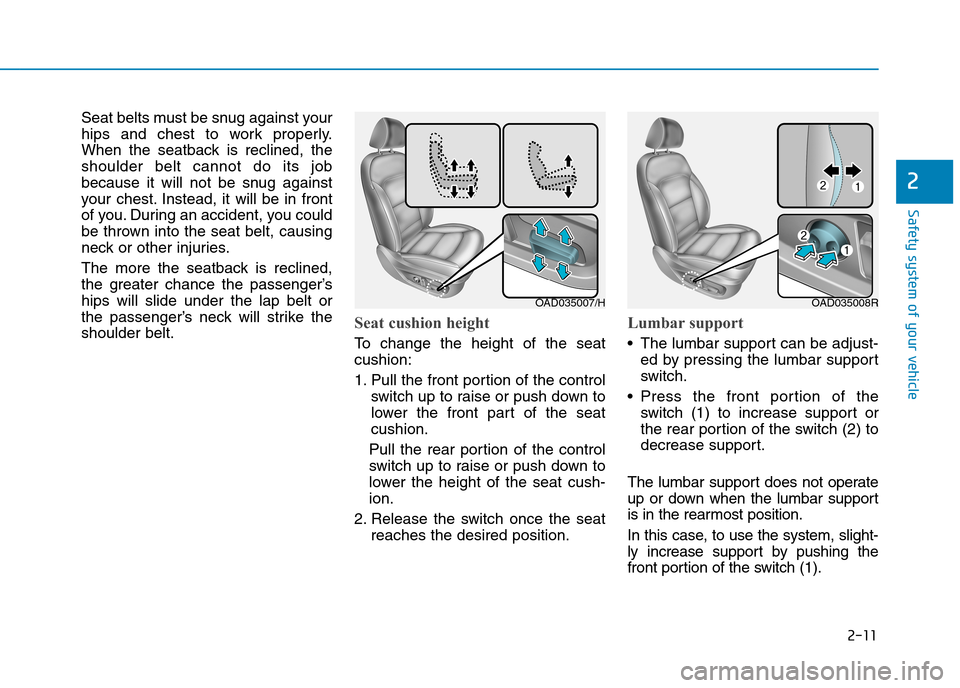
2-11
Safety system of your vehicle
2
Seat belts must be snug against your
hips and chest to work properly.
When the seatback is reclined, the
shoulder belt cannot do its job
because it will not be snug against
your chest. Instead, it will be in front
of you. During an accident, you could
be thrown into the seat belt, causing
neck or other injuries.
The more the seatback is reclined,
the greater chance the passenger’s
hips will slide under the lap belt or
the passenger’s neck will strike the
shoulder belt.Seat cushion height
To c h a n g e t h e h e i g h t o f t h e s e a t
cushion:
1. Pull the front portion of the control
switch up to raise or push down to
lower the front part of the seat
cushion.
Pull the rear portion of the control
switch up to raise or push down to
lower the height of the seat cush-
ion.
2. Release the switch once the seat
reaches the desired position.
Lumbar support
•The lumbar support can be adjust-
ed by pressing the lumbar support
switch.
•Press the front portion of the
switch (1) to increase suppor t or
the rear portion of the switch (2) to
decrease support.
The lumbar support does not operate
up or down when the lumbar support
is in the rearmost position.
In this case, to use the system, slight-
ly increase support by pushing the
front portion of the switch (1).
OAD035007/HOAD035008R
Page 39 of 571
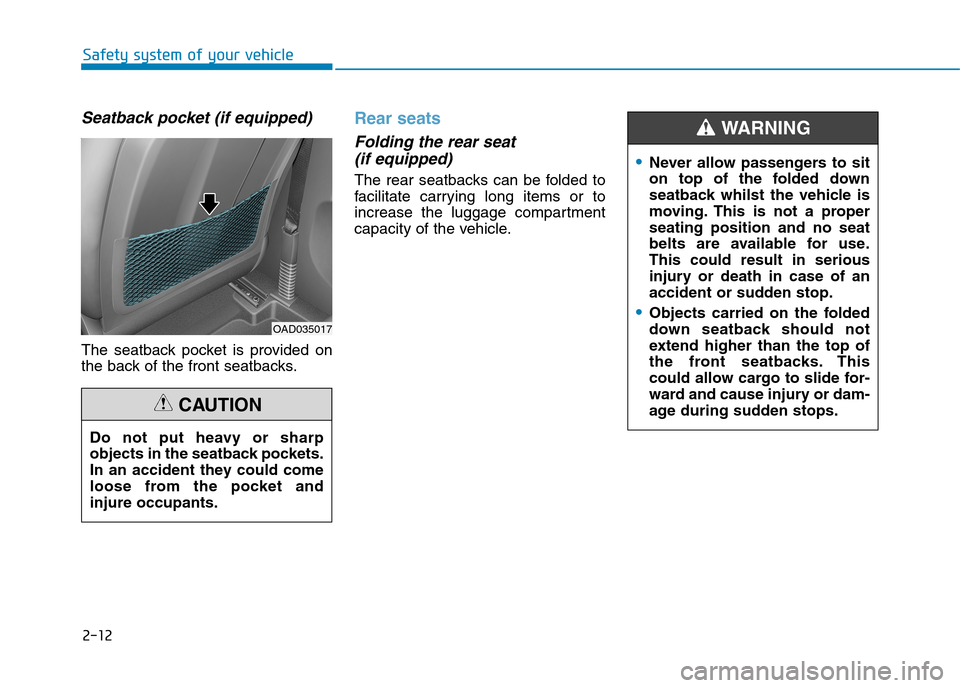
2-12
Safety system of your vehicle
Seatback pocket (if equipped)
The seatback pocket is provided on
the back of the front seatbacks.
Rear seats
Folding the rear seat
(if equipped)
The rear seatbacks can be folded to
facilitate carr ying long items or to
increase the luggage compartment
capacity of the vehicle.
Do not put heavy or sharp
objects in the seatback pockets.
In an accident they could come
loose from the pocket and
injure occupants.
CAUTION
OAD035017
•Never allow passengers to sit
on top of the folded down
seatback whilst the vehicle is
moving. This is not a proper
seating position and no seat
belts are available for use.
This could result in serious
injury or death in case of an
accident or sudden stop.
•Objects carried on the folded
down seatback should not
extend higher than the top of
the front seatbacks. This
could allow cargo to slide for-
ward and cause injury or dam-
age during sudden stops.
WA R N I N G
Page 50 of 571
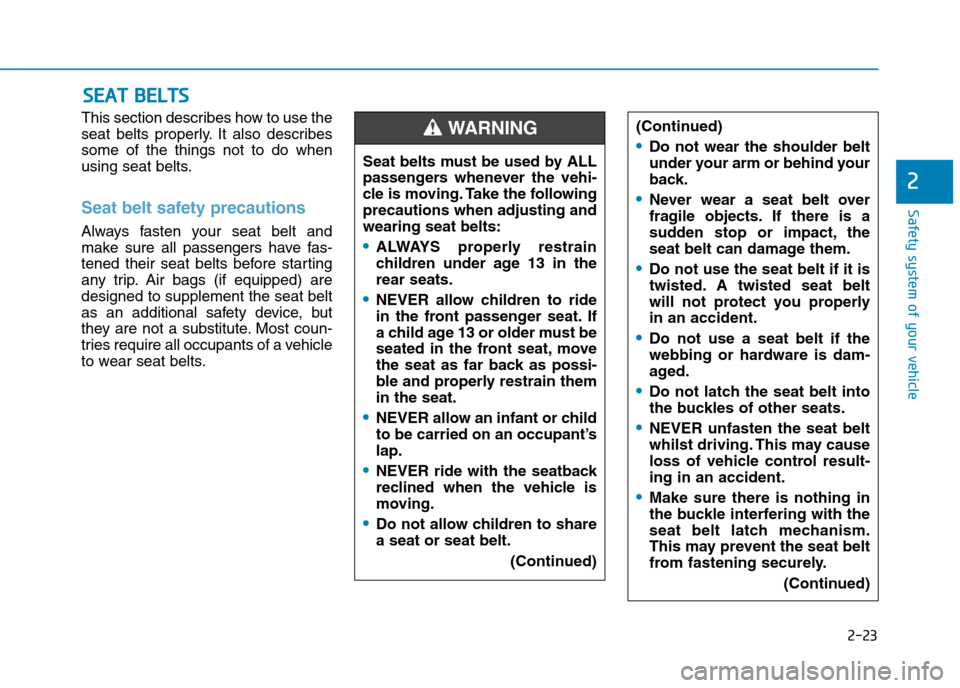
2-23
Safety system of your vehicle
2
This section describes how to use the
seat belts properly. It also describes
some of the things not to do when
using seat belts.
Seat belt safety precautions
Always fasten your seat belt and
make sure all passengers have fas-
tened their seat belts before starting
any trip. Air bags (if equipped) are
designed to supplement the seat belt
as an additional safety device, but
they are not a substitute. Most coun-
tries require all occupants of a vehicle
to wear seat belts.
SSEEAATT BBEELLTTSS
Seat belts must be used by ALL
passengers whenever the vehi-
cle is moving. Take the following
precautions when adjusting and
wearing seat belts:
•ALWAYS properly restrain
children under age 13 in the
rear seats.
•NEVER allow children to ride
in the front passenger seat. If
a child age 13 or older must be
seated in the front seat, move
the seat as far back as possi-
ble and properly restrain them
in the seat.
•NEVER allow an infant or child
to be carried on an occupant’s
lap.
•NEVER ride with the seatback
reclined when the vehicle is
moving.
•Do not allow children to share
a seat or seat belt.
(Continued)
WA R N I N G (Continued)
•Do not wear the shoulder belt
under your arm or behind your
back.
•Never wear a seat belt over
fragile objects. If there is a
sudden stop or impact, the
seat belt can damage them.
•Do not use the seat belt if it is
twisted. A twisted seat belt
will not protect you properly
in an accident.
•Do not use a seat belt if the
webbing or hardware is dam-
aged.
•Do not latch the seat belt into
the buckles of other seats.
•NEVER unfasten the seat belt
whilst driving. This may cause
loss of vehicle control result-
ing in an accident.
•Make sure there is nothing in
the buckle interfering with the
seat belt latch mechanism.
This may prevent the seat belt
from fastening securely.
(Continued)
Page 51 of 571
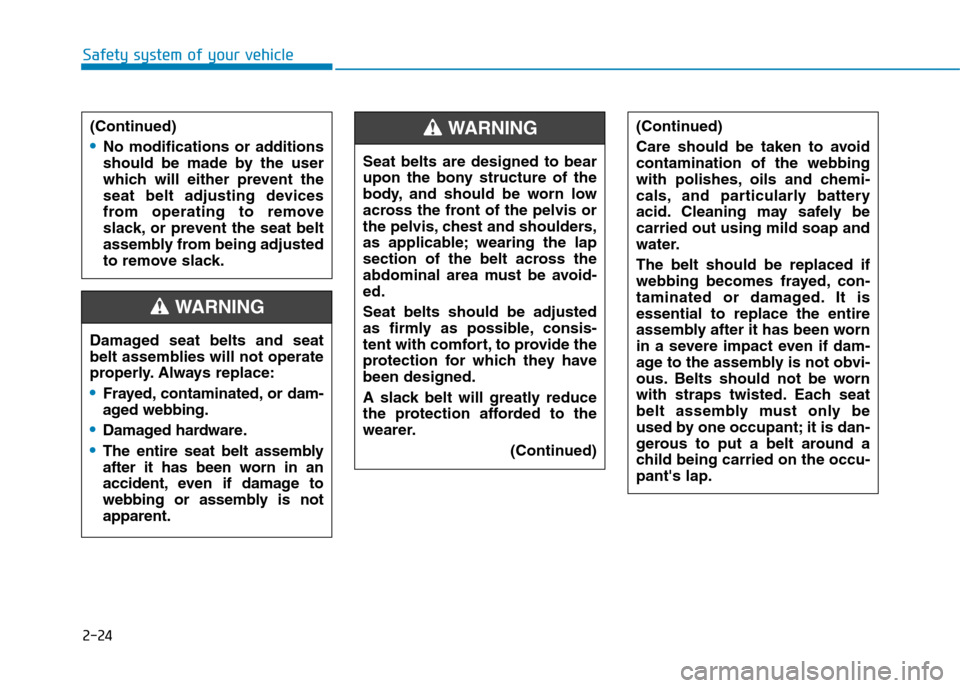
2-24
Safety system of your vehicle
Damaged seat belts and seat
belt assemblies will not operate
properly. Always replace:
•Frayed, contaminated, or dam-
aged webbing.
•Damaged hardware.
•The entire seat belt assembly
after it has been worn in an
accident, even if damage to
webbing or assembly is not
apparent.
WA R N I N G
(Continued)
•No modifications or additions
should be made by the user
which will either prevent the
seat belt adjusting devices
from operating to remove
slack, or prevent the seat belt
assembly from being adjusted
to remove slack.
Seat belts are designed to bear
upon the bony structure of the
body, and should be worn low
across the front of the pelvis or
the pelvis, chest and shoulders,
as applicable; wearing the lap
section of the belt across the
abdominal area must be avoid-
ed.
Seat belts should be adjusted
as firmly as possible, consis-
tent with comfort, to provide the
protection for which they have
been designed.
A slack belt will greatly reduce
the protection afforded to the
wearer.
(Continued)
WA R N I N G (Continued)
Care should be taken to avoid
contamination of the webbing
with polishes, oils and chemi-
cals, and particularly battery
acid. Cleaning may safely be
carried out using mild soap and
water.
The belt should be replaced if
webbing becomes frayed, con-
taminated or damaged. It is
essential to replace the entire
assembly after it has been worn
in a severe impact even if dam-
age to the assembly is not obvi-
ous. Belts should not be worn
with straps twisted. Each seat
belt assembly must only be
used by one occupant; it is dan-
gerous to put a belt around a
child being carried on the occu-
pant's lap.
Page 52 of 571
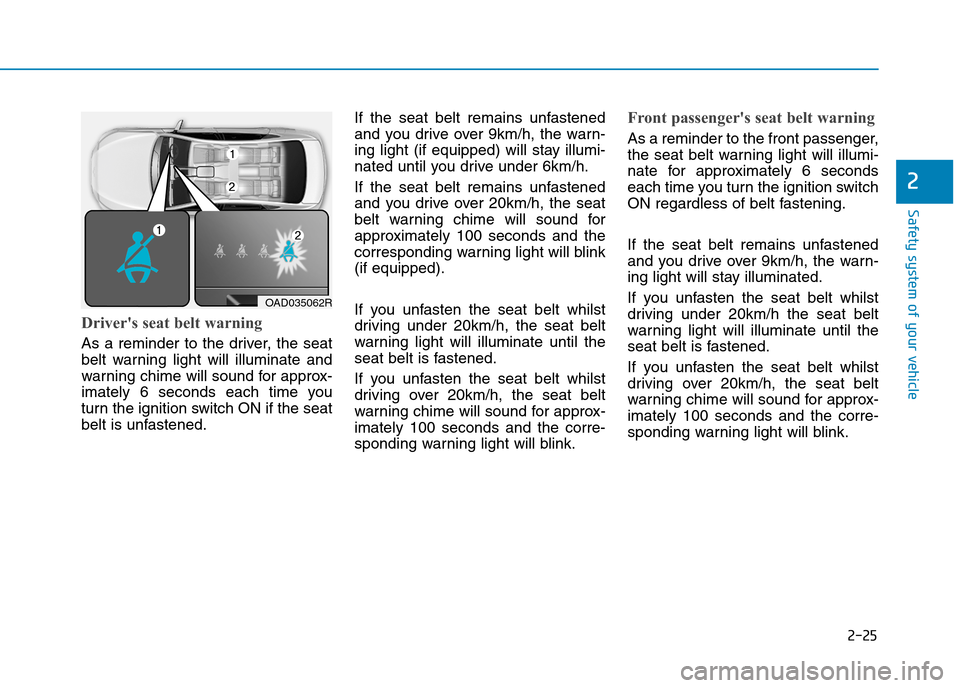
2-25
Safety system of your vehicle
Driver's seat belt warning
As a reminder to the driver, the seat
belt warning light will illuminate and
warning chime will sound for approx-
imately 6 seconds each time you
turn the ignition switch ON if the seat
belt is unfastened.
If the seat belt remains unfastened
and you drive over 9km/h, the warn-
ing light (if equipped) will stay illumi-
nated until you drive under 6km/h.
If the seat belt remains unfastened
and you drive over 20km/h, the seat
belt warning chime will sound for
approximately 100 seconds and the
corresponding warning light will blink
(if equipped).
If you unfasten the seat belt whilst
driving under 20km/h, the seat belt
warning light will illuminate until the
seat belt is fastened.
If you unfasten the seat belt whilst
driving over 20km/h, the seat belt
warning chime will sound for approx-
imately 100 seconds and the corre-
sponding warning light will blink.
Front passenger's seat belt warning
As a reminder to the front passenger,
the seat belt warning light will illumi-
nate for approximately 6 seconds
each time you turn the ignition switch
ON regardless of belt fastening.
If the seat belt remains unfastened
and you drive over 9km/h, the warn-
ing light will stay illuminated.
If you unfasten the seat belt whilst
driving under 20km/h the seat belt
warning light will illuminate until the
seat belt is fastened.
If you unfasten the seat belt whilst
driving over 20km/h, the seat belt
warning chime will sound for approx-
imately 100 seconds and the corre-
sponding warning light will blink.
2
OAD035062R
Page 53 of 571
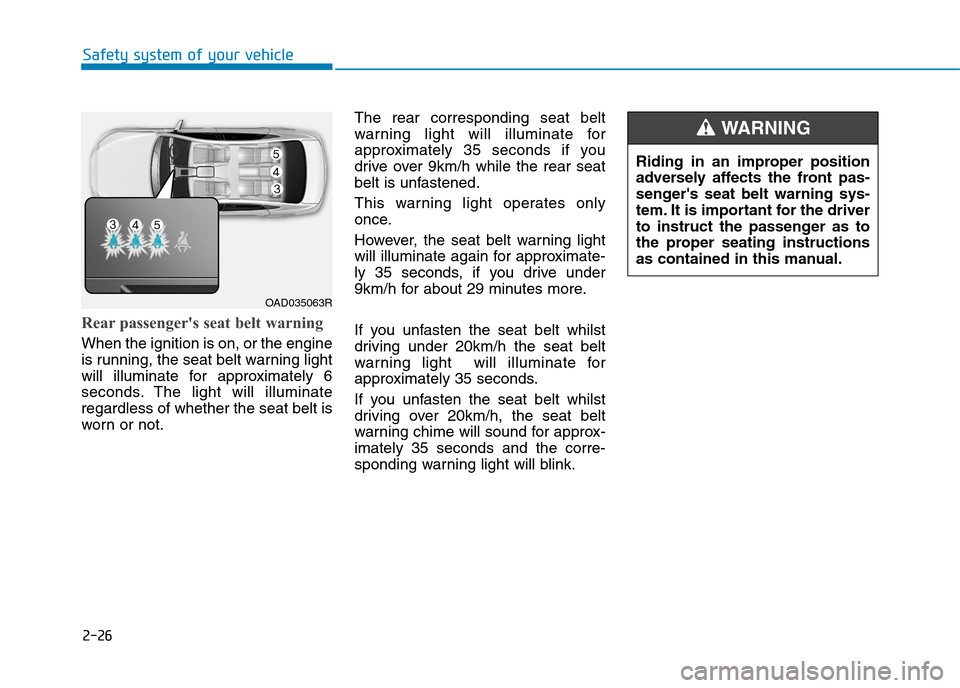
2-26
Rear passenger's seat belt warning
When the ignition is on, or the engine
is running, the seat belt warning light
will illuminate for approximately 6
seconds. The light will illuminate
regardless of whether the seat belt is
worn or not.
The rear corresponding seat belt
warning light will illuminate for
approximately 35 seconds if you
drive over 9km/h while the rear seat
belt is unfastened.
This warning light operates only
once.
However, the seat belt warning light
will illuminate again for approximate-
ly 35 seconds, if you drive under
9km/h for about 29 minutes more.
If you unfasten the seat belt whilst
driving under 20km/h the seat belt
warning light will illuminate for
approximately 35 seconds.
If you unfasten the seat belt whilst
driving over 20km/h, the seat belt
warning chime will sound for approx-
imately 35 seconds and the corre-
sponding warning light will blink.
Safety system of your vehicle
Riding in an improper position
adversely affects the front pas-
senger's seat belt warning sys-
tem. It is important for the driver
to instruct the passenger as to
the proper seating instructions
as contained in this manual.
WA R N I N G
OAD035063R
Page 54 of 571
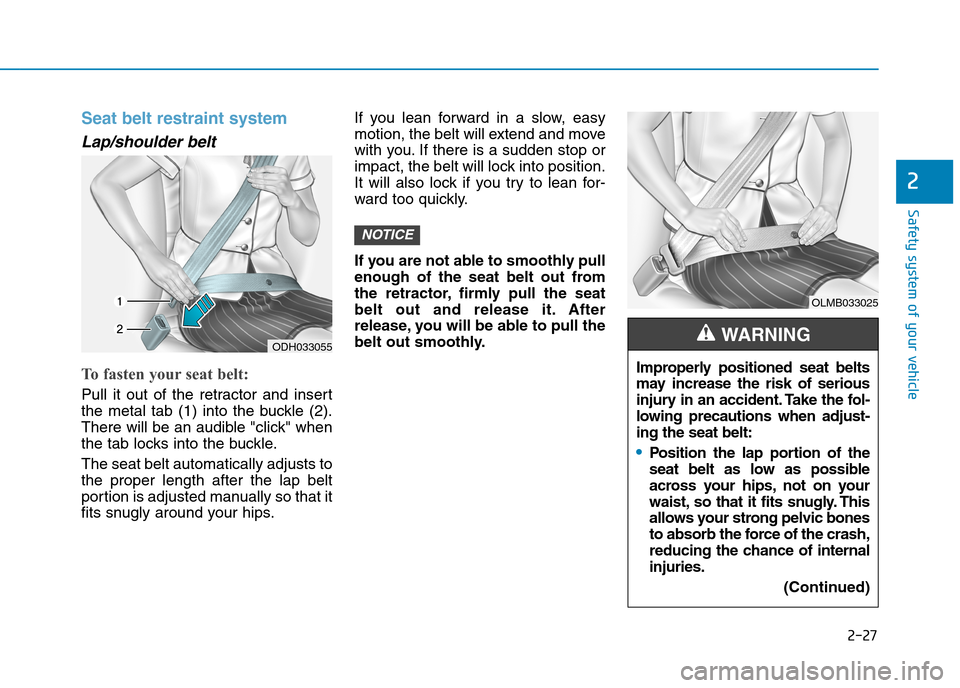
2-27
Safety system of your vehicle
2
Seat belt restraint system
Lap/shoulder belt
To fasten your seat belt:
Pull it out of the retractor and insert
the metal tab (1) into the buckle (2).
There will be an audible "click" when
the tab locks into the buckle.
The seat belt automatically adjusts to
the proper length after the lap belt
portion is adjusted manually so that it
fits snugly around your hips.
If you lean forward in a slow, easy
motion, the belt will extend and move
with you. If there is a sudden stop or
impact, the belt will lock into position.
It will also lock if you try to lean for-
ward too quickly.
If you are not able to smoothly pull
enough of the seat belt out from
the retractor, firmly pull the seat
belt out and release it. After
release, you will be able to pull the
belt out smoothly.
NOTICE
ODH033055
OLMB033025
Improperly positioned seat belts
may increase the risk of serious
injury in an accident. Take the fol-
lowing precautions when adjust-
ing the seat belt:
•Position the lap por tion of the
seat belt as low as possible
across your hips, not on your
waist, so that it fits snugly. This
allows your strong pelvic bones
to absorb the force of the crash,
reducing the chance of internal
injuries.
(Continued)
WA R N I N G
Page 55 of 571
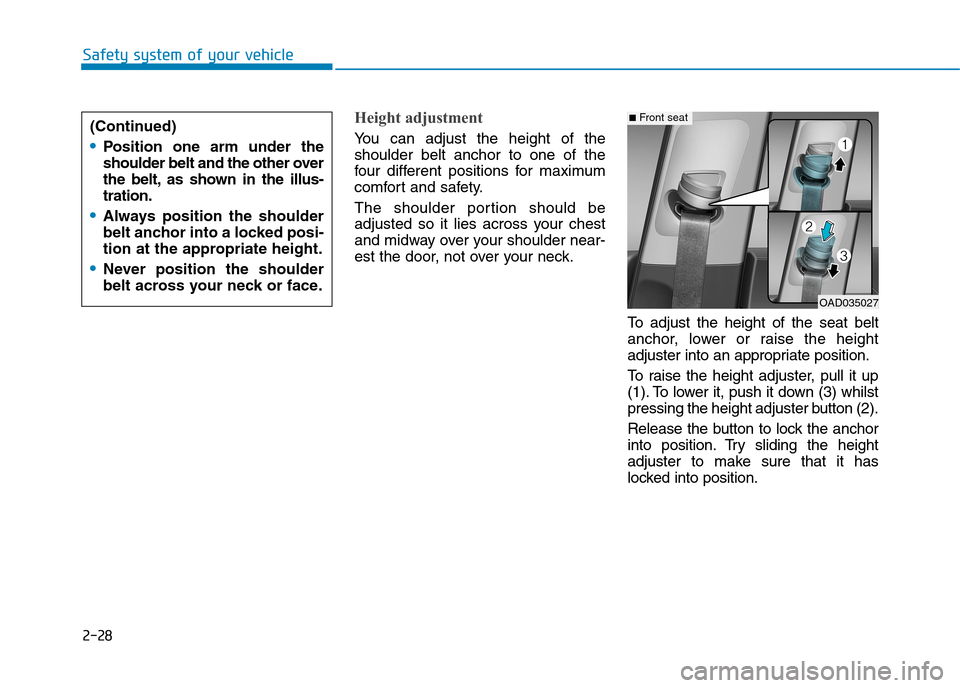
2-28
Safety system of your vehicle
Height adjustment
Yo u c a n a d j u s t t h e h e i g h t o f t h e
shoulder belt anchor to one of the
four different positions for maximum
comfort and safety.
The shoulder portion should be
adjusted so it lies across your chest
and midway over your shoulder near-
est the door, not over your neck.
To a d j u s t t h e h e i g h t o f t h e s e a t b e l t
anchor, lower or raise the height
adjuster into an appropriate position.
To r a i s e t h e h e i g h t a d j u s t e r , p u l l i t u p
(1). To lower it, push it down (3) whilst
pressing the height adjuster button (2).
Release the button to lock the anchor
into position. Try sliding the height
adjuster to make sure that it has
locked into position.
OAD035027
■Front seat(Continued)
•Position one arm under the
shoulder belt and the other over
the belt, as shown in the illus-
tration.
•Always position the shoulder
belt anchor into a locked posi-
tion at the appropriate height.
•Never position the shoulder
belt across your neck or face.